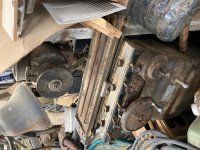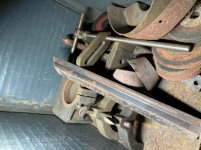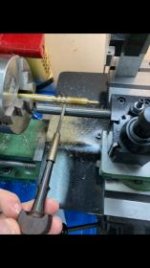Thanks for all of the input. I already have a diamond wheel grinder for carbide and a proper bit sharpener (drill doctor) which works well enough for my needs for bits up to 3/4". Through my estate sale extravaganzas, I have more bits than I can dull in a lifetime, so my needs for a tool sharpener are basically
zero.
I was really looking for a small hobby surface grinder that would actually fit in my shop and could get down the stairs. I want something that would allow me to make a nice finish on small parts. Its looking like this unit may be a square peg in a round hole? Its not clear to me how much refurb it will take to work well, but I'm assuming it will be as much effort my Myford was (two month refurb). I find that sort of work fun, as long as I have some reference material to work off of, but I have not found any good info online, video or otherwise on the small KO's. But I am getting expert at rust removal and if I need to make small parts, my other machines can accommodate that. I assume if I need new K.O.-specific parts, that is a nightmare situation.
Michiganbuck, the table does not appear to rotate. I saw a pic online that showed curved ways on the right side, under this unit looks much like a XY mill table. The head presumably rotates though. Wheel spindle has some slop but otherwise moves pretty nice for unlubricated. "chip breaker grinder" is what the manual cover called it here:
http://vintagemachinery.org/pubs/1738/6626.pdf I cant believe there was an entire machine devoted to grinding chip breakers, but I guess there is. "If the wheel spindle feels gritty load it with spindle oil and go ahead and try it for a time at low RPM (300)to hope to wash out the rust, likely you cant save it that way but it is worth a try." Does this imply that fluid is somehow pumped through the system? I didn't see any provisions for that. I don't even know if it has an oil reservoir and will be a nightmare to transport. Underneath I only saw grease nipples. See here:
The motor appeared to be in very good shape. Its a 110v GE and there was no slop anywhere on the shaft. I'll look for the oiler, but I think most of those old GE's are sealed and robust. I have one on my Delta belt sander that recommends "oiling after 10 years of normal use!" The plug was smashed so I couldn't test it, and I would rewire it with a motor casing ground.
Stephen, I have not run a surface grinder before. I'm about 3 hours from you. It would be well within budget, but I don't want to put a lot of money into it as it will be a low use machine for me. I'm not sure I'd even repaint it after cleaning it up (But I would likely fully disassemble and check it out). Is the main problem that the X axis will take more turns than a proper surface grinder and as a result its a lot more work?
4GSR, you have a keen eye, it was just a blade fixture that was lying on top of the machine, not part of it.
I have a simple on/off level mag chuck. Its not electrical (I don't know much about these, I recently bought it for another fixture use).
4" x 7" Permanent Magnetic Chuck, Rectangular Fine Pole Sealed Chuck, High Precision Hoist Crane Magnet For Grinding Machine Inch Manufacturing Workholding (150x450mm) - - Amazon.com Is that not going work? I have a V and square mag blocks too.
So, if this unit was inexpensive, is it worth the effort to spend a couple weeks cleaning it up and ordering a couple hundred in parts to get it operational? Can I get a decent surface grind (mirror finish) out of it on a 3" flat part? I don't mind if its a little more effort, or has a little less height adjustment accuracy than a proper 2 ton machine. I'd likely use it to just pretty up surfaces that have been milled to get the machine marks out. I'd also use it to true up surfaces on small parts. I am refurbishing a tiny Unimat lathe right now and I could clean up a lot of those parts nicely (grinding off surface rust, or re-parallel'ing mounting surfaces). Most of my work centers around aesthetic or non critical dimensions. I'm just a hobbyist.
Someone said its easy to remove the bed. How is that done so I can investigate the ways?
Thanks again for the insight, really helpful!


















 I've put in hours of elbow grease, new bearings, QCTP, baldor 1hp motor, teco vfd, controller, etc. to make it a very pleasurable and capable device. When I bought it, it didn't look much better than this grinder.
I've put in hours of elbow grease, new bearings, QCTP, baldor 1hp motor, teco vfd, controller, etc. to make it a very pleasurable and capable device. When I bought it, it didn't look much better than this grinder. 

